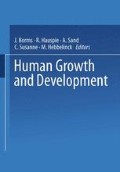Abstract
This discussion of psychosocial factors in development will be restricted to human studies relating to physical and cognitive growth. We will further restrict the consideration of psychosocial factors to a limited group of variables relating to family structure and functioning.
Access this chapter
Tax calculation will be finalised at checkout
Purchases are for personal use only
Preview
Unable to display preview. Download preview PDF.
References
Baldwin, W., and Cain, V.S., 1980, The children of teenage parents. Family Planning Perspectives, 12 (1): 34–43.
Belmont, L., 1979, The effect of mother’s age at first birth upon the IQ’s of subsequent children, Paper delivered at Contractor’s Workshop on the Effects of Adolescent Childbearing on the child, Bethesda, Maryland.
Belmont, L., and Morolla, F.A., 1973, Birth order, family size, and intelligence, Science, 182: 1096–1101.
Belmont, L., Stein, Z.A,, and Susser, M.W., 1975, Comparisons of associations of birth order with intelligence test score and height, Nature, 255: 54–56.
Berbaum, M.L., and Moreland, R.L., 1980, Intellectual development within the family: A new application of the confluence model, Developmental Psychology, 16: 506–515.
Braman, S.H., 1980, Outcome of adolescent pregnancy: A report from the Collaborative Perinatal Project, in: S. Hare l, ed., The At-Risk Infant, Amsterdam, Excerpta Medica.
Chamberlain, R., Chamberlain, G., Howlett, B., and Claireaux, A., 1975, British births, 1970, London, W. Heinemann Medical Books, Ltd.
Clausen, J.A., 1966, Family structure, socialization, and personality, in: L.W. Hoffman and M.L. Hoffman, eds., Review of child Development Research, Chicago, University of Chicago Press.
Davie, R., Butler, N.R., and Goldstein, H., 1972, From birth to seven, London, Lon.+.ans.
Douglas, J.W.B., 1964, The home and the school, London, Macgibbon and Kee.
Evans, S., Reinhard, J.B., and Succop, F.A., 1972, Failure to thrive, A study of 45 children and their families, Journal of the American Academy of Child Psychiatrists, 2: 440–457.
Eysenck, H.J., and Cookson, D., 1970, Personality in primary school children, 3-Family background, British Journal of Educational Psychology, 40: 117–131.
Glass, D.C., Neulingern J., and Brim, 0.,’1974, Birth order, verbal intelligence, and educational aspiration, Child Development, 45: 807–811.
Goldstein, H., 1971, Factors influencing the height of seven-year-old children-results from the national child development study, Human Biology, 43 (1): 92–111.
Goodwin, D.V., 1978, GCRC research teams study link between psychosocial dwarsfism and child abuse, Research Resources Reporter, 7: 1–6.
Grant, M.W., 1964, Rate of growth in relation to birth rank and family size, British Journal of Preventive and Social Medicine, 18: 35–42.
Herzog, E., and Sudia, C., 1973, Children in fatherless families, in: B. Caldwell and H. Riccuiti, eds., Review of Child development Research, Chicago, University of Chicago Press.
Hufton, I., and Oates, R., 1977, Nonorganic failure to thrive, A longterm follow-up, Pediatrics, 59: 73–77.
Kellam,’S.G., Ensminger, M.E., and Turner, J., 1977, Fatnily structure and the mental health of children, Archives of Genera Psychiatry, 34: 1012–1022.
Koch, H.L., 1954, The relation of primary mental abilities in fiveand six-year-olds to sex of child and characteristics of his sibling, Child Development, 25: 209–223.
Mednick, B.R., Baker, R.L., and Sutton-Smith, B., 1979, Teenage pregnancy and perinatal mortality, Journal of Youth and Adolescence, 8: 343–357.
Mednick, S.A., and Volavka, J., 1980, Biology and crime, in: N. Morris and M. Tonry, eds., Crime and Justice, An annual review of research, Vol. II, Chicago, University of Chicago Press.
Moffitt, T.E., Gabrielli, W.F., Mednick, S.A., and Schulsinger, F., 1981, Socioeconomic status, I.Q. and delinquency, Journal of Abnormal Psychology, 90: 152–156.
Money, J., 1977, The syndrome of abuse dwarfism, American Journal, of Diseases of Children, 131: 508–513.
Money, J., and Werlwas, J., 1976, Folie a deux in the parents of psychosocial dwarfs, Two cases, Bulletin of the American Academy of Psychiatry and the Law, 3: 351–362.
Money, J., and Wolff, G., 1974, Late puberty, retarded growth and reversible: hyposomatotropinism, Adolescence, 9: 121–134.
Nuttall, E.V., Nuttall, R.L., Polit, D., and Hunter, J.B,, 1976, The effects of famiyl size, birth order, sibling separation and crowding on the academic achievement of..boys and girls, American Educational Research Journal, 13 (3): 217–223.
Record, R.G., McKeown, T., and Edwards, J.H., 1969, Annals of human Genetics, 33: 61–69.
Rosenberg, B.G., and Sutton-Smith, B., 1966, Sibling association, family size, and cognitive abilities, Journal of Genetic Psychology, 109: 271–279.
Shaheen, E., Alexander, D., Truskowsky, M., Barbero, ure to thrive-a retrospective profile, Clinica Pediatrics, 7: 255–261.
Shinn, M., 1978, Father absence and children’s cognitive development, Psychological Bulletin, 85 (2): 295–324.
Svanum, S., and Bringle,’R.G., 1980, Evaluation of confluence model variables on IQ and achievement test scores in a sample of 6-to 11-year-old children, Journal of Educational Psychology, 72: 427–436.
Terhune, K.W., 1974, A review of the actual and expected consequences of family size, Calspan Report n°. DP-5333-G-I, U.S. Department of Health, Education, and Welfare.
Tanner, J.M., 1970, Physical growth, in: P.H. Mussen, ed., Carmichael’s manual of child psychology, vol. 2, New York, John Wiley and Sons.
Van Dusen, K., Mednick, S.A., and Gabrielli, W., 1983, Social class and crime in an adoption cohort, to be published.
Wallenstein, J., and Kelly, F., 1976, The effects of parental divorce, The experience of the child in later latency, American Journal of Orthopsychiatry, 46: 256–269.
Wolfgang, M.F., Figlio, R., and Sellin, T., 1972, Delinquency in a birth cohort, Chicago, University of Chicago Press.
Zajonc, R.B., 1976, Family configuration and intelligence, Science, 192: 227–236.
Zajonc, R.B., and Bergh, J., 1980, Birth order, family size and decline of SAT scores, American Psychologist, 35: 662–668.
Zajonc, R.B., and Markus, G.B., 1975, Birth order and intellectual development, Psychological Review, 82: 74–88.
Author information
Authors and Affiliations
Editor information
Editors and Affiliations
Rights and permissions
Copyright information
© 1984 Springer Science+Business Media New York
About this chapter
Cite this chapter
Mednick, B.R., Finello, K.M., Baker, R.L., Mednick, S.A. (1984). Psychosocial Aspects of Growth. In: Borms, J., Hauspie, R., Sand, E.A., Susanne, C., Hebbelinck, M. (eds) Human Growth and Development. Springer, Boston, MA. https://doi.org/10.1007/978-1-4757-0743-4_70
Download citation
DOI: https://doi.org/10.1007/978-1-4757-0743-4_70
Publisher Name: Springer, Boston, MA
Print ISBN: 978-1-4757-0745-8
Online ISBN: 978-1-4757-0743-4
eBook Packages: Springer Book Archive

